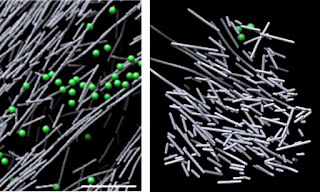We know your cells have switches, now we know they have scaffolds to do work too....For by him were all things created, that are in heaven, and that are in earth, visible and invisible...Colossians 1:16
"There are many times when our cells need to move. Mobile cells guide our body's formation (embryonic development). Immune cells roam to capture unwanted intruders. And healing cells (fibroblasts) migrate to mend wounds.
But not all movement is desirable: Tumors are most dangerous when cancer cells gain the ability to travel throughout the body (metastasis). Certain bacteria and viruses can harness the cells' motility machinery to invade our bodies.
Understanding how cells move—and the rod-like actin filaments that drive the process—is key to learning how to halt or promote motility to improve human health.
Now, using one of the most powerful microscopes in the world, scientists....have identified a dense, dynamic and disorganized actin filament nanoscaffold—resembling a haystack—that is induced in response to a molecular signal.
This is the first time researchers have directly visualized, at the molecular level, a structure that is triggered in response to a cellular signal—a key finding that expands our understanding of how cells move..... tailor-made computational and cell imaging approaches to compare nanoscale images of mouse fibroblasts to time-stamped light images of fluorescent Rac1, a protein that regulates cell movement, response to force or strain (mechanosensing) and pathogen invasion. This technically complex workflow—which bridged five orders of magnitude in scale.
The images revealed a densely packed, disorganized, scaffold-like structure comprised of short actin rods.
These structures sprang into view in defined regions where Rac1 was activated, and quickly dissipated when Rac1 signaling stopped—in as little as two and a half minutes. This dynamic scaffold contrasted sharply with various other actin assemblies in areas of low Rac1 activation—some comprised of long, aligned rods of actin, and others comprised of short actin rods branching from the sides of longer actin filaments. The volume encasing the actin scaffold was devoid of common cellular structures, such as ribosomes, microtubules, vesicles and more, likely due to the structure's intense density..... "We were surprised that experiment after experiment revealed these unique hotspots of unaligned, densely packed actin rods in regions that correlated with Rac1 activation," says Niels Volkmann..."We believe this disorder is actually the scaffold's strength—it grants the flexibility and versatility to build larger, complex actin filament architectures in response to additional local spatial cues.".....
Hanein adds, "Actin is a building-block protein; it interacts with more than 150 actin binding proteins to generate diverse structures, each serving a unique function. We have a surplus of different signals that we would like to map, which could yield even more insights into how cells move."
Phys.org
"There are many times when our cells need to move. Mobile cells guide our body's formation (embryonic development). Immune cells roam to capture unwanted intruders. And healing cells (fibroblasts) migrate to mend wounds.
But not all movement is desirable: Tumors are most dangerous when cancer cells gain the ability to travel throughout the body (metastasis). Certain bacteria and viruses can harness the cells' motility machinery to invade our bodies.
Understanding how cells move—and the rod-like actin filaments that drive the process—is key to learning how to halt or promote motility to improve human health.
Now, using one of the most powerful microscopes in the world, scientists....have identified a dense, dynamic and disorganized actin filament nanoscaffold—resembling a haystack—that is induced in response to a molecular signal.
This is the first time researchers have directly visualized, at the molecular level, a structure that is triggered in response to a cellular signal—a key finding that expands our understanding of how cells move..... tailor-made computational and cell imaging approaches to compare nanoscale images of mouse fibroblasts to time-stamped light images of fluorescent Rac1, a protein that regulates cell movement, response to force or strain (mechanosensing) and pathogen invasion. This technically complex workflow—which bridged five orders of magnitude in scale.
The images revealed a densely packed, disorganized, scaffold-like structure comprised of short actin rods.
These structures sprang into view in defined regions where Rac1 was activated, and quickly dissipated when Rac1 signaling stopped—in as little as two and a half minutes. This dynamic scaffold contrasted sharply with various other actin assemblies in areas of low Rac1 activation—some comprised of long, aligned rods of actin, and others comprised of short actin rods branching from the sides of longer actin filaments. The volume encasing the actin scaffold was devoid of common cellular structures, such as ribosomes, microtubules, vesicles and more, likely due to the structure's intense density..... "We were surprised that experiment after experiment revealed these unique hotspots of unaligned, densely packed actin rods in regions that correlated with Rac1 activation," says Niels Volkmann..."We believe this disorder is actually the scaffold's strength—it grants the flexibility and versatility to build larger, complex actin filament architectures in response to additional local spatial cues.".....
Hanein adds, "Actin is a building-block protein; it interacts with more than 150 actin binding proteins to generate diverse structures, each serving a unique function. We have a surplus of different signals that we would like to map, which could yield even more insights into how cells move."
Phys.org


